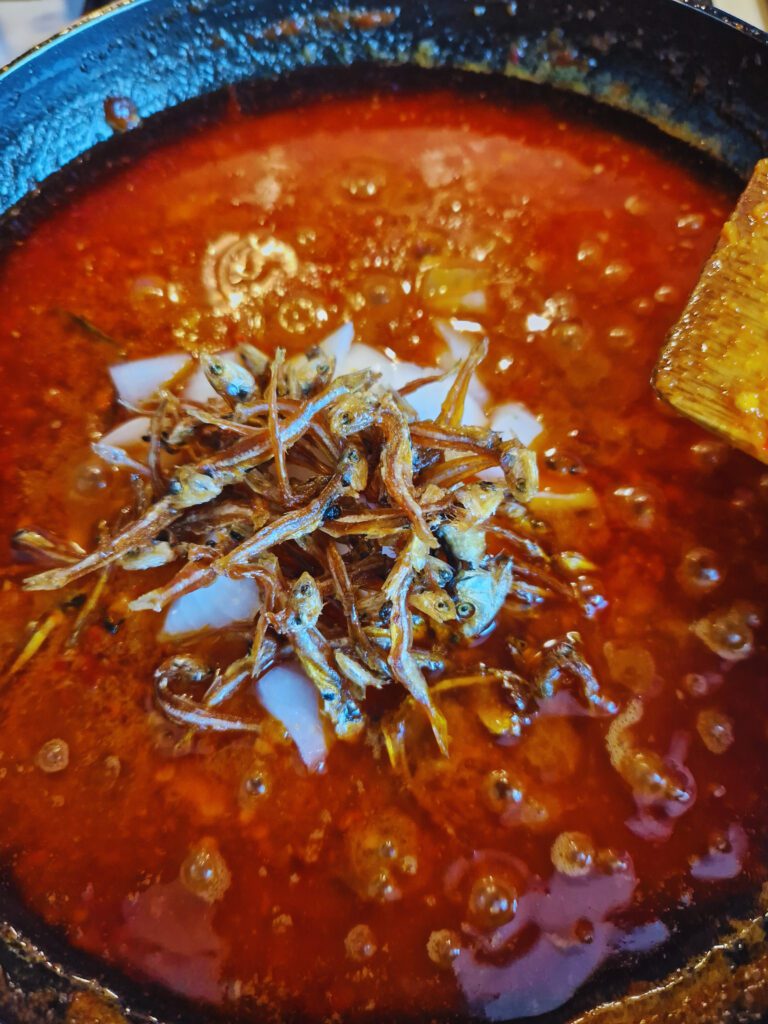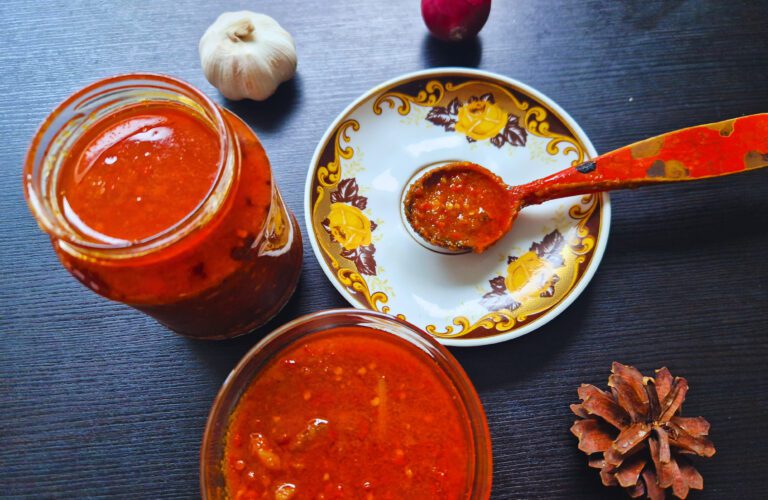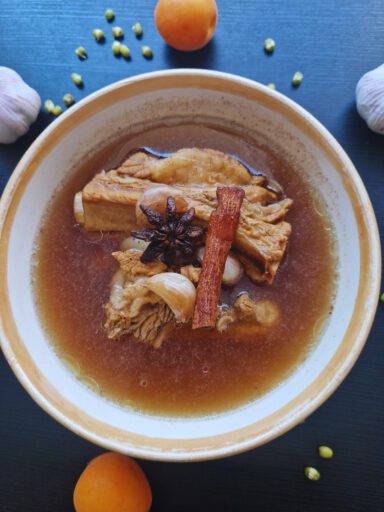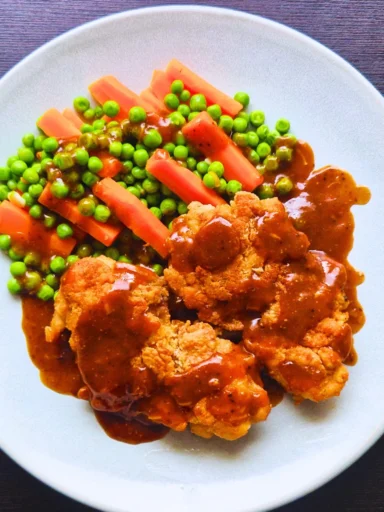Ah, Nasi Lemak – the undisputed king of Malaysian breakfasts! It’s like this fragrant pyramid of coconut rice, fluffy and bursting with pandan leaf aroma.
But you can’t have Nasi Lemak without the real star of the show: the sambal.
This fiery chili paste is like a flavor bomb, adding a sweet, spicy, and savory kick to every bite. From the moment you wake up to the smell of it sizzling in the morning markets, you know it’s going to be a good day.
Nasi Lemak with sambal is more than just a meal, it’s a true Malaysian experience!
More Recipes Like This
- How to Make Sambal Ikan Bilis (Easy & Spicy Recipe!)
- How to Make Sambal Oelek?
- Easy Sambal Matah (So Fresh & Spicy!)
- Easy Chili Oil (Just 10 Minutes)
- Sambal Goreng (Stir-fry Potato)
What Makes a Perfect Nasi Lemak Sambal?
Malaysian Nasi Lemak wouldn’t be the same without its fiery soul mate – the sambal. This condiment is a symphony of flavors, traditionally made with key ingredients like:
- Spicy Base: The foundation of heat comes from fiery chilies like cayenne or bird’s eye chilies. Some regions might even use dried shrimp paste (belacan) for an extra punch.
- Aromatic Symphony: Shallots, garlic, and lemongrass add a fragrant depth, while turmeric lends a warm, earthy note.
- Sweet & Tangy Twist: Palm sugar provides a touch of sweetness, balanced by the tang of lime juice or tamarind.
But sambal isn’t a one-size-fits-all condiment. The beauty lies in its regional variations:
- Penang: Known for its use of toasted candlenuts for a richer, nuttier flavor.
- Kelantan: Features dried shrimp paste (belacan) for a stronger umami punch.
- East Coast: Often incorporates fresh turmeric and galangal for a more earthy profile.
The key is achieving the perfect balance – a fiery dance between sweet, spicy, and tangy notes. This flavor harmony is what makes sambal so addictive and the essential companion to Nasi Lemak, elevating it from a simple dish to a beloved Malaysian staple.
Gather Your Goodies: Essential Ingredients for Nasi Lemak Sambal

Malaysian sambal is a flavor explosion, and crafting your own lets you control the heat and customize it to your taste. Here’s a breakdown of the key ingredients and sourcing tips:
- Chilies (fresh or dried): The fiery heart of sambal. Fresh options like cayenne or bird’s eye chilies deliver vibrant heat and flavor. Look for them in the Asian section of your grocery store or ethnic markets. Dried chilies (soaked beforehand) offer a more intense, concentrated heat.
Tip: Wear gloves when handling chilies to avoid burning your fingers. If fresh chilies are unavailable, substitute with ½ teaspoon crushed red pepper flakes for every 2-3 fresh chilies but be aware the flavor won’t be as fresh and vibrant.
- Shallots & Garlic (fresh): These aromatic allies add depth and complexity. Fresh is best! Find shallots in the produce section of most grocery stores, near the onions and garlic.
- Lemongrass (fresh): Look for fresh lemongrass stalks in the Asian section of your grocery store. It has a citrusy, slightly floral aroma. Some supermarkets sell pre-chopped lemongrass, but fresh delivers the best flavor.
Tip: If you can’t find fresh lemongrass, substitute with ½ teaspoon lemongrass paste (found in the Asian section) or ¼ teaspoon ground lemongrass.
- Turmeric (fresh or ground): Fresh turmeric root offers the most vibrant flavor and color, but ground turmeric is readily available in the spice section.
- Belacan (dried shrimp paste, optional): This ingredient adds a salty, umami punch, but it can be strong. Find it in Southeast Asian grocery stores. Substitute with 1 tablespoon of fish sauce for a milder alternative.
- Palm Sugar (preferred) or Brown Sugar: Palm sugar adds a unique caramel-like sweetness. Look for it in the Asian section, but brown sugar works in a pinch.
- Lime Juice or Tamarind Paste: These add a necessary tang to balance the sweetness and heat. Use bottled lime juice or fresh if available. Tamarind paste, found in the Asian section, offers a more complex sourness.
Fresh vs. Dried: The Flavor Advantage
Fresh ingredients always deliver the most vibrant flavor and aroma. However, dried alternatives offer convenience and can still create a delicious sambal. If using dried ingredients, soak them in hot water for 15-20 minutes to rehydrate and release their flavors before adding them to your sambal.
With this ingredient list and sourcing tips, you’re ready to embark on your sambal-making adventure! Remember, substitutions can work, but fresh ingredients will always create the most authentic and flavorful sambal.
Cook Up a Storm: Making Nasi Lemak Sambal
Ready to transform your taste buds with the magic of homemade sambal? Here’s a detailed guide to walk you through the process:
Gather Your Arsenal (Ingredients):
- 10-12 pieces Dried Chilies
- 10 pieces Fresh Red Chilies
- 20 gr Dried Anchovies
- 3 pieces Candlenuts
- 3 pieces Shallots
- 10 cloves Garlic
- 1 stalk (white part) Lemongrass
- 4 gr Belacan (dried shrimp paste)
- Palm Sugar (or Brown Sugar)
- 1 tbsp Lime Juice (or 1 tsp Tamarind Paste)
- Vegetable Oil
- Salt (to taste)
Prepping for Flavor town:
- Heat Up the Anchovies: In pan fry the dried anchovies. Add 1 tbsp oil until crispy. Remove and set aside.

2. Heat Up the Party: Combine chopped ingredients (chilies, shallots, garlic, lemongrass, candlenuts, soaked anchovies) in a food processor or blender—pulse for a coarse mixture. For me I like to blend it separately between chilies and other ingredients.

3. Oil Slick: Heat oil in a pan (medium heat). Add the blended shallot, garlic, candlenuts and anchovies and cook (5-7 minutes), stirring often, until fragrant and softened. Then add chili paste cook about 10 minutes.

4. Sweet & Sour Serenade: Add belacan (if using), palm sugar (or brown sugar), and lime juice (or tamarind paste)—season with salt.5
5. Texture Tango: Add sweet white onion and cook for another 5-7 minutes, stirring occasionally, until desired consistency (spreadable paste, not puree). And the last add fried anchovies.

6. Spice Control: Taste your sambal throughout the cooking process. If it’s too, add little more palm sugar to balance the heat.

Tips for the Spice Master:
- Start Low, Go Slow: Gradually increase chilies for your spice preference.
- Seed Strategy: Removing some or all chili seeds reduces heat.
- Resting Fury: Let sambal rest 30 minutes after cooking for flavors to meld.
Nasi Lemak Sambal: Flavor & Function
While Nasi Lemak Sambal is a delicious and iconic dish, it’s important to consider its nutritional profile:
- Coconut Milk: Rich in healthy fats but also adds calories. Use a smaller portion or light coconut milk.
- Chilies: Low in calories but high in vitamins A and C. Enjoy the heat, but remember portion control.
- Rice: A good source of carbs, but opt for brown rice for added fiber.
Nasi Lemak Sambal in a Balanced Diet:
Nasi Lemak Sambal can still be part of a healthy diet! Here’s how:
- Portion Control: Enjoy a moderate serving of Nasi Lemak Sambal, focusing on vegetables and lean protein alongside it.
- Mind the Sides: Opt for healthier accompaniments like grilled fish or steamed vegetables instead of fried options.
- Overall Balance: Throughout the day, ensure your meals are rich in fruits, vegetables, and whole grains to balance any indulgence.
Moderation is Key:
Treat Nasi Lemak Sambal as a special occasion or occasional indulgence. Here are some moderation tips:
- Frequency: Enjoy it once or twice a week, not every day.
- Portion Size: Focus on smaller portions and savor each bite.
- Pair Wisely: Choose healthier accompaniments and balance it with lighter meals throughout the day.
Sambal Savvy: Tips and Tricks for Perfect Results
Even the best chefs make mistakes! Here’s how to avoid common pitfalls and create perfect Nasi Lemak Sambal:
Sambal SOS:
- Too Spicy: Don’t go overboard with chilies! Start with less and adjust the heat as you go. Removing seeds helps too.
- Not Spicy Enough: If your sambal lacks fire, add a pinch of cayenne pepper or a touch more chopped chili.
- Bland and Boring: Did your sambal miss the flavor mark? Double-check your ingredients – did you forget the aromatics like lemongrass or shallots?
- Too Sweet: Palm sugar adds sweetness, but too much can overpower the dish. Use a light hand and taste as you go. If needed, add a squeeze of lime juice for balance.
- Too Salty: Be mindful of the salt content, especially if using belacan (shrimp paste). Taste before adding extra salt.
Rice Rescue:
- Mushy Rice: Did your rice turn out mushy? Ensure you rinsed the rice thoroughly to remove excess starch. Also, check your water-to-rice ratio – a 1:1 ratio of coconut milk to water is a good starting point.
Storage Savvy:
- Leftover Love: Store leftover sambal in an airtight container in the refrigerator for up to a week. Reheat gently in a pan over low heat to preserve the flavors.
- Coconut Rice Caution: Leftover coconut rice can dry out. Store it in an airtight container in the refrigerator for up to 2 days. Reheat with a splash of water or coconut milk to restore moisture.
With a little practice and these helpful tips, you’ll be whipping up restaurant-worthy Nasi Lemak Sambal in no time!
Wrap It Up: Final Thoughts on Nasi Lemak Sambal
Conquer Nasi Lemak Sambal, the iconic Malaysian dish! Master the fragrant sambal, fluffy rice, and savor the sweet, spicy, tangy flavors. Share your creations online and inspire others! Dive deeper – explore more Malaysian recipes and cooking tips with us. Become a Malaysian food master!

Create Your Own Nasi Lemak Sambal
Ingredients
Method
- In pan fry the dried anchovies. Add 1 tbsp oil until crispy. Remove and set aside.
- Combine chopped ingredients (chilies, shallots, garlic, lemongrass, candlenuts, soaked anchovies) in a food processor or blender—pulse for a coarse mixture. For me I like to blend it separately between chilies and other ingredients.
- Heat oil in a pan (medium heat). Add the blended shallot, garlic, candlenuts and anchovies and cook (5-7 minutes), stirring often, until fragrant and softened. Then add chili paste cook about 10 minutes.
- Add belacan (if using), palm sugar (or brown sugar), and lime juice (or tamarind paste)—season with salt.
- Add sweet white onion and cook for another 5-7 minutes, stirring occasionally, until desired consistency (spreadable paste, not puree). And the last add fried anchovies.
- Taste your sambal throughout the cooking process. If it's too, add little more palm sugar to balance the heat.





